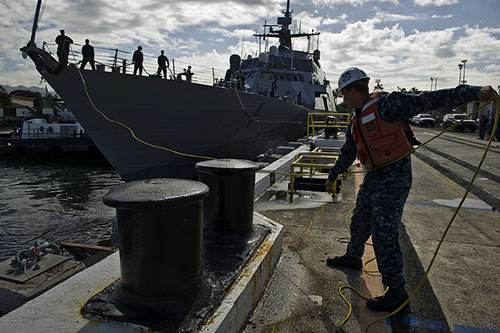The Armed Forces of the United States are structured, according to the main doctrine of reference, so as to simultaneously confront and win two hostile countries anywhere in the world, while guaranteeing the internal defense of the country against an enemy in possession of the best existing military technology . A doctrine that has always seen two factions opposed within the Pentagon.
The first focuses entirely on the "presence" strategy, which provides for the fixed redeployment of troops and inexpensive weapons systems in the main hot spots on the planet. The concept of "Presence" is based on the ability to prevent a possible conflict precisely because of the permanence of a large operating battle group (at low cost). This concept is countered by the strategy of the "capability" which involves the redeployment of the latest generation of weapon systems in the main American bases on the planet. The concept of "capacity" is based on the power of the platforms, deployed in smaller numbers, which have the task of decapitating the enemy leadership while waiting for the bulk of the forces. Concepts that clashed again on the cutting of the Littoral Combat Ship, reduced in the new defense budget to 40 units compared to the initially planned 52.
The history of the fleet composed, in theory, by small fast ships, well armed and highly flexible, has always been plagued by design flaws (and waste). Obviously, 40 ships will guarantee a lower presence compared to a fleet composed of 52 boats (initially they had to be 72). We know that the funds saved, about 5,5 billion dollars, will be allocated to other systems and platforms.
 Designed since the 90 years and developed following the concept of modularity, the Littoral Combat Ships have tripled their initially estimated cost, reaching the 550 million dollars per unit ceiling (even if we already talk about 700 thousand dollars per boat with the new changes). What is believed to be one of the Pentagon's main mistakes on the LCS affair was that it had "burned" billions of dollars in the procurement of the Littoral Combat Ship to two different manufacturers. A two-fold and totally different construction strategy that bled the Defense budget. The two versions created are so different that separate training programs for staff and assistance have been created. A unicum, probably, in the world panorama.
Designed since the 90 years and developed following the concept of modularity, the Littoral Combat Ships have tripled their initially estimated cost, reaching the 550 million dollars per unit ceiling (even if we already talk about 700 thousand dollars per boat with the new changes). What is believed to be one of the Pentagon's main mistakes on the LCS affair was that it had "burned" billions of dollars in the procurement of the Littoral Combat Ship to two different manufacturers. A two-fold and totally different construction strategy that bled the Defense budget. The two versions created are so different that separate training programs for staff and assistance have been created. A unicum, probably, in the world panorama.
As if that were not enough, on Littoral Combat Ship structural problems were found. In several reports published by the Pentagon, the real capacity of the Littoral Combat Ship. In three different reports, from 2011 to 2013, various critical issues have been found that led to the same conclusion: "the USS Freedom, the first LCS built by Lockheed Martin, would not have survived in a hostile combat environment".
Despite the devices of the Navy, on Littoral Combat Ship we continued to encounter problems with the materials used in the load-bearing structures (they rusted too quickly) and the excessive vibrations of the main guns that made the aim unstable after the first salvage. Problems also with integrated weapons systems and "deficiencies in the performance of hostile contact management".
 Finally, the LCS proved to be too "light". An enemy, not in possession of the same technology, could have suffered twice the damage, representing a threat anyway. In the 2013 the entire offensive system of the ship was branded as "highly unstable". The improvements were approved in December of the 2013, but in a new report in March of the 2014 it emerged that "the changes would not add anything to the ship's current survival capacity deemed unsatisfactory. The only effective solutions would involve a new design or a fundamental modification to the project ”.
Finally, the LCS proved to be too "light". An enemy, not in possession of the same technology, could have suffered twice the damage, representing a threat anyway. In the 2013 the entire offensive system of the ship was branded as "highly unstable". The improvements were approved in December of the 2013, but in a new report in March of the 2014 it emerged that "the changes would not add anything to the ship's current survival capacity deemed unsatisfactory. The only effective solutions would involve a new design or a fundamental modification to the project ”.
Despite everything, the program Littoral Combat Ship keep it going. The future boats will be equipped with kevlar internal armor, new weapon and avionics systems as well as some tricks to reduce the radar signature. It should be noted that the multi-mission modular packages are still purely theoretical and that between the 50 and the 60% of the implemented technologies are not considered operational. The development of LCS continues to be plagued by various problems that, in a few years, could also be solved at a price, however, much higher than expected. The future LCSs, designed to be small ships, will in effect be frigates.
The project for warships "small" is to be considered officially closed.
(photo: US DoD)












